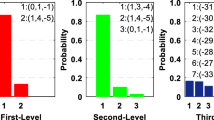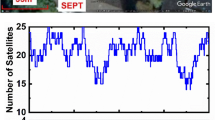Abstract
The Hatch–Melbourne–Wübbena (HMW) combination is a geometry-free and ionospheric-free (first-order) function that has been widely used for cycle slip detection and ambiguity resolution in GNSS dual-frequency data processing. We investigate the characteristics of HMW combinations for BeiDou navigation satellite system (BDS) observations for different types of satellites. We first study the characteristics of BDS undifferenced (UD) HMW combinations. Obvious systematic errors are found on BDS UD HMW combinations. The characteristics of single-differenced (SD) and double-differenced (DD) HMW combinations are then analyzed. The results indicate that the biases do not cancel in single-differencing between two satellites. On the contrary, they are amplified because of the superposition of the systematic biases of two satellite signals. In single-differencing between two receivers, different characteristics are found for different satellites types depending on baseline length. For inclined geostationary orbit (IGSO) and Medium Earth Orbit (MEO), the systematic biases cancel for single-differencing between receivers or double-differencing over short and medium baselines; however, they do not cancel in single-differencing between receivers or double-differencing over long baselines. Regarding geostationary earth orbit (GEO), the systematic biases do not cancel for single-differencing between receivers or double-differencing over both short and long baselines. In addition, we analyze the sources of the systematic biases of the BDS HMW combination. The systematic biases of IGSO and MEO HMW combinations mainly originate from multipath errors at the satellite; the systematic biases of GEO HMW combinations may also originate from multipath errors. Finally, we study the influence of the systematic errors on wide-lane ambiguity resolution by analyzing the consistency of the fractional part of the averaged SD HMW combinations and the fixing rate of DD wide-lane ambiguity resolution. The results are compared with those of GPS.















Similar content being viewed by others
References
Blewitt G (1989) Carrier phase ambiguity resolution for the global positioning system applied to geodetic baselines up to 2000 km. J Geo-phys Res 94:135–151
Blewitt G (1990) An automatic editing algorithm for GPS data. Geophys Res Lett 17(3):199–202
Bock Y, Gourewitch SA, Counselmann CC, King RW, Abbot RI (1986) Interferometric analysis of GPS phase observations. Manuscr Geod 11(4):282–288
Estey LH, Meertens CM (1999) TEQC: the multi-purpose toolkit for GPS/GLONASS data. GPS Solut 3(1):42–49
Ge M, Gendt G, Rothacher M, Shi C, Liu J (2008) Resolution of GPS carrier-phase ambiguities in precise point positioning (PPP) with daily observations. J Geod 82(7):389–399
Gendt G, Dick G, Reigber CH, Tomassini M, Liu Y, Ramatschi M (2003) Demonstration of NRT GPS water vapor monitoring for numerical weather prediction in Germany. J Meteorol Soc Jpn 82(1B):360–370
Hatch R (1982) The synergism of GPS code and carrier measurements. In: Proceedings of the third international symposium on satellite doppler positioning at physical sciences laboratory of New Mexico State University, Feb 8–12, vol 2, pp 1213–1231
Hauschild A, Montenbruck O, Sleewaegen JM, Huisman L, Teunissen P (2012) Characterization of compass M-1 signals. GPS Solut 16(1):117–126
He H, Li J, Yang Y, Xu J, Guo H, Wang A (2013) Performance assessment of single- and dual-frequency BeiDou/GPS single-epoch kinematic positioning. GPS Solut 18(3):393–403
Hu Z, Chen G, Zhang Q, Guo J, Su X, Li X, Zhao Q, Liu J (2013) An initial evaluation about BDS navigation message accuracy. In: Proceedings of China satellite navigation conference (CSNC) 2013. Lecture notes in electrical engineering 243. Springer, Berlin, pp 479–491. doi:10.1007/978-3-642-37398-5_44
Kee C, Parkinson B (1994) Calibration of multipath errors on GPS pseudorange measurements. ION-GPS-1994, Salt Lake City, UT, 20–23 Sep 1994, pp 353–362
Li X, Ge M, Zhang H, Nischan T, Wickert J (2013a) The GFZ real-time GNSS precise positioning service system and its adaption for COMPASS. Adv Space Res 51(6):1008–1018
Li X, Ge M, Zhang H, Wickert J (2013b) A method for improving uncalibrated phase delay estimation and ambiguity-fixing in real-time precise point positioning. J Geod 87(5):405–416
Li X, Ge M, Dai X, Ren X, Fritsche M, Wickert J, Schuh H (2015) Accuracy and reliability of multi-GNSS real-time precise positioning: GPS, GLONASS, BeiDou, and Galileo. J Geod 89(6):607–635
Melbourne W (1985) The case for ranging in GPS-based geodetic systems. In: First international symposium on precise positioning with the global positioning system, Rockville, pp 373–386
Montenbruck O, Rizos C, Weber R, Weber G, Neilan R, Hugentobler U (2013) Getting a grip on multi-GNSS—the international GNSS service MGEX campaign. GPS World 24(7):44–49
Nadarajah N, Teunissen PJG, Raziq N (2013) BeiDou inter-satellite-type bias evaluation and calibration for mixed receiver attitude determination. Sensors 13(7):9435–9463
Teunissen PJG (2001) Integer estimation in the presence of biases. J Geod 75(7–8):399–407
Teunissen PJG (2002) The parameter distributions of the integer GPS model. J Geod 76(1):41–48
Teunissen PJG, Odolinski R, Odijk D (2014) Instantaneous BeiDou + GPS RTK positioning with high cut-off elevation angles. J Geod 88(4):335–350. doi:10.1007/s00190-013-0686-4
Wang G, de Jong K, Li X, Zhao Q, Guo J (2014) Analysis of characteristics of BDS observable combinations for wide-lane integer ambiguity resolution In: Sun J, Jiao W, Wu H, Shi C (eds) Proceedings of China satellite navigation conference (CSNC) 2014
Wanninger L, Beer S (2014) BeiDou satellite-induced code pseudorange variations: diagnosis and therapy. GPS Solut. doi:10.1007/s10291-014-0423-3
Wübbena G (1985) Software developments for geodetic positioning with GPS using TI-4100 code and carrier measurements. In: First international symposium on precise positioning with the global positioning system, Rockville, pp 403–412
Xu A, Xu Z, Xu X, Zhu H, Sui X, Sun H (2014) Precise point positioning using the regional BeiDou navigation satellite constellation. J Navig 67(03):523–537
Zhang B, Teunissen PJG (2015) Zero-baseline analysis of GPS/BeiDou/Galileo between-receiver differential code biases (BRDCBs): time-wise retrieval and preliminary characterization. In: Proceedings ION-PNT, Hawaii, pp 107–116
Zhang F, He H, Tang B, Shen F, Chen R (2013) Analysis of signal characteristics and positioning performance affected by pseudo range multipath for COMPASS. In: Sun J, Jiao W, Wu H, Shi C (eds) Proceedings of China satellite navigation conference (CSNC) 2013. Lecture notes in electrical engineering, vol 243, 15–17 May, Wuhan. Springer, Berlin, pp 493–503
Acknowledgments
The authors gratefully acknowledge IGS and GNSS Research Centre of Curtin University (Australia) for providing BDS data and products. The BeiDou data sets collected from WUHAN CORS network were used in this study, which is acknowledged. We also appreciate two anonymous reviewers for their valuable comments and improvements to this manuscript. This study was supported by the National Natural Science Foundation of China (No: 41474025, 41204030 and 41304005) and Natural Science Foundation for Distinguished Young Scholar of Hubei Province of China (No: 2015CFA039).
Author information
Authors and Affiliations
Corresponding author
Rights and permissions
About this article
Cite this article
Zhang, X., He, X. & Liu, W. Characteristics of systematic errors in the BDS Hatch–Melbourne–Wübbena combination and its influence on wide-lane ambiguity resolution. GPS Solut 21, 265–277 (2017). https://doi.org/10.1007/s10291-016-0520-6
Received:
Accepted:
Published:
Issue Date:
DOI: https://doi.org/10.1007/s10291-016-0520-6




